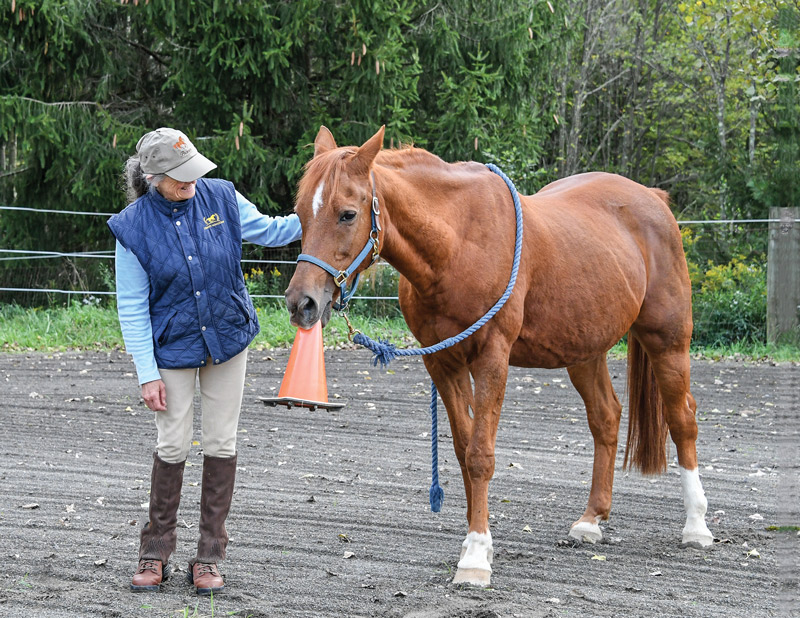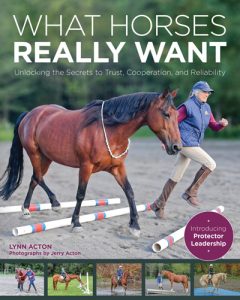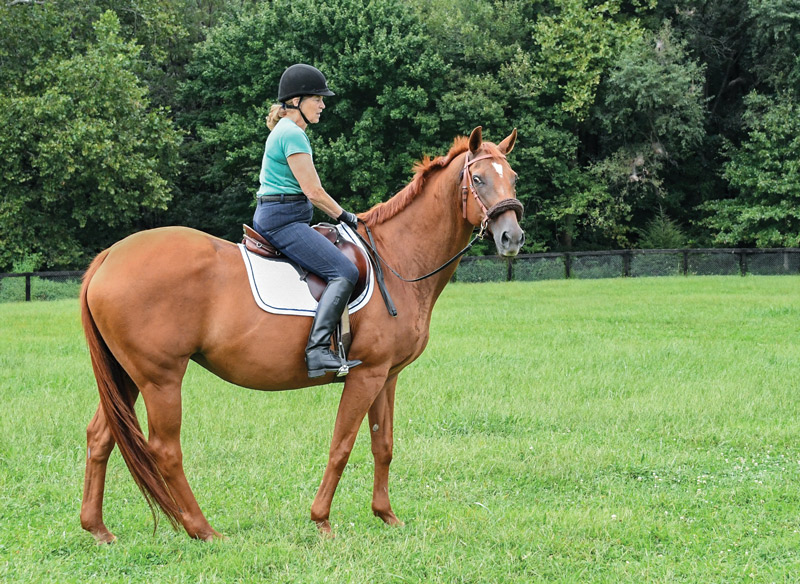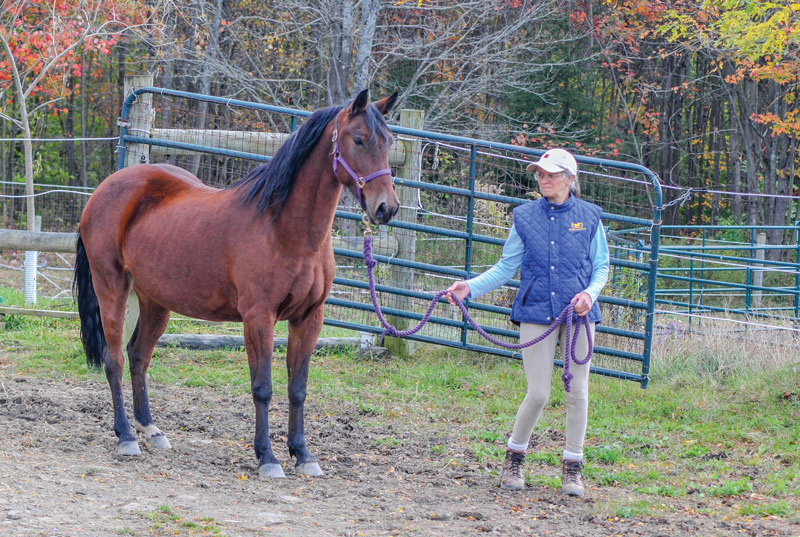

This excerpt from What Horses Really Want by Lynn Acton is adapted and reprinted with permission from Trafalgar Square Books (www.horseandriderbooks.com).
But, these actions can be misconstrued as disobedience. They might even be punished. It is like being with someone who ignores what we say, and it places a negative interpretation on everything we do. When we do this to our horses, we overlook important information, and turn ourselves into a source of anxiety instead of security.
Common actions of horses who are acting like partners, which might be mistaken for “bad” behavior, include:
◆ Initiating an action in an attempt to communicate with you.
◆ Pausing or experimenting to figure out what you want.
◆ Anticipating what you are going to ask.
◆ Volunteering an action that has been rewarded in the past.
◆ Disobeying for what the horse believes to be a good reason.
◆ Showing signs of trust and attachment.
Here, we will explore the last two.
Disobeying
Next to our farm is a state forest. Our horses, Bronzz and Sapphire, learned the trails on our end of it the first year we lived here. One day, both of them flatly refused to cross a culvert they’d crossed before without hesitation.

My husband and I agreed this was not disobedience; it was a warning. Even though the culvert looked fine to us, the horses did not trust it. They readily agreed to an alternative that was much more work since we had to bushwhack through underbrush, scoot down a muddy creek bank, clamber across rocks, climb up the other bank, and squeeze through a maze of saplings.
Their suspicions were validated a couple weeks later when we got a phone call from a friend who rides the same trails. Erosion around the culvert had created dangerous sinkholes that were now obvious.
Refusing to obey a command for a valid reason is called “intelligent disobedience.” Service dogs are taught to do this. It is what stops a guide dog from leading his handler into traffic. For a horse, warning us of possible danger is part of being a responsible herd member or partner.
Horses see, hear, smell, and feel (through their hooves) things that we cannot. Faulty or misunderstood cues from a rider often require a horse to guess what to do.
Unexpected circumstances may require a horse to react faster than we can. Horses who have been punished for using their own judgment can actually be more dangerous.
My worst fall occurred when a horse obeyed my faulty command, and we landed on top of a jump. Had he refused, I would have been spared a serious injury. That was when I recognized the danger of demanding absolute obedience.

Intelligent disobedience is at work when horses slow down for insecure footing, refuse to go forward onto footing that looks unreliable, refuse jumps because their rider is poorly balanced, or opt to detour around situations that look risky. No prey animal wants to risk falling or getting trapped, and his caution protects us, too.
Some people fear that letting horses “get away with disobeying” undermines future obedience. My experience is exactly the opposite. When we fail to trust our horses’ good judgment, we lose credibility. When you trust your horse, he is more likely to trust you when you do need to overrule him. If you suspect a horse could be right about danger, you retain your position as decision-maker by deciding on Plan B after the horse has warned you that Plan A might be risky.
Signs of Trust and Attachment
Your horse’s attachment to you is significant, and not only for sentimental reasons. Horses who are attached to their trainer have a stronger sense of security, and therefore are calmer, more focused, and able to learn. Horses who lack this security are more likely to be fearful and distracted. Thus, attachment impacts the success of training, independent of the techniques used.
People may not doubt that their dogs love them, yet few notice that their horses are attached to them. The idea is even scoffed at by many, and surely it is easier to sell a horse if we don’t believe the horse cares. But many do care … and deeply.
We saw it the day our horse Sapphire was delivered to us. Her teenage owner was committed to showing in western pleasure. Sapphire despised ring work and repetition but was reliable on trails. A career change made good sense.
When Melissa brought Sapphire to us, Sapphire appeared to think they were on a routine clinic or lesson expedition. She dove happily into the clover-laced grass in the little pasture where we turned her out, until she saw Melissa’s truck and trailer disappearing down the road without her. Then she ran to the edge of the pasture screaming that heart-rending “don’t leave me!” whinny.
It was very clear a year later when we left her overnight at the equine hospital at Cornell University in preparation for a lameness exam. Her desperate calls rang in our ears as we left and met us when we arrived the next morning. The moment she saw us, she quieted, and became a model patient.
Possibly Sapphire got unusually attached to people, but I do not think so. I think she was just quicker to suspect she was being left behind permanently, and more eloquent about showing her distress.
Signs of attachment can be so mundane that they are misinterpreted or overlooked altogether, such as:
◆ Welcoming us with a nicker
◆ Leaving a hay pile to greet us
◆ Relaxing contentedly when we groom, talk to them, scratch itchy spots, or just hang out
◆ Not walking off immediately when we turn them out, and
◆ Tuning in to us even when we’re not asking for anything.
Attention-seeking is another sign of attachment, as are changes in behavior when we’ve been away. The most disconcerting sign of attachment is a horse “clinging” to us when he is scared. If a horse has not learned to stay out of our personal space, it can feel like he is trying to run us over. Yet, he is really acting like a scared foal who wants to press himself to his mother’s side.
Since no one wants a half-ton panic attack plastered to her side, it is hard to see this behavior as a positive sign that he is looking for our leadership. A horse who learns to respect personal space can look to us for reassurance and guidance without becoming a danger.
Things to Try
Think of positive behaviors you’ve observed that show your horse is thinking like a partner; if your responses have not encouraged these behaviors, what could you change?
And finally, watch for behaviors that might be misconstrued as disobedience but are really expressions of your horse’s unique personality. Consider positive ways to respond to these behaviors.
This article from the book What Horses Really Want appeared in the October 2020 issue of Horse Illustrated magazine. Click here to subscribe!





